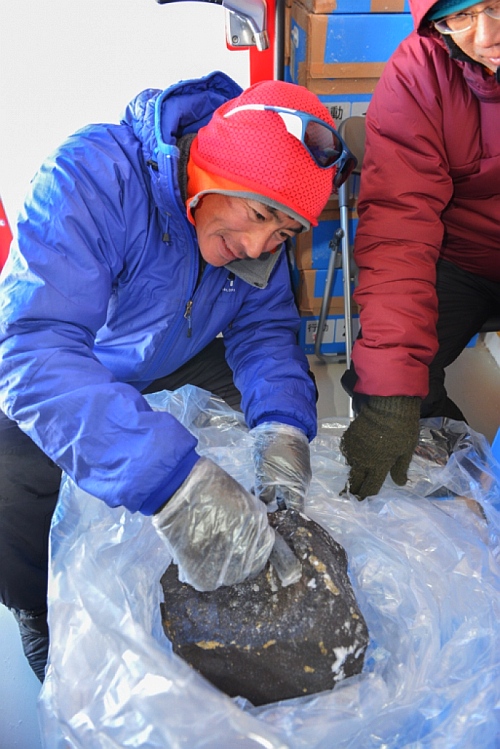Photographs: Picture courtesy: International Polar Foundation
An international team of scientists has discovered a 18kg meteorite in Antarctica -- the largest in nearly 25 years, which may help unlock the secrets of our solar system.
Scientists, working at Princess Elisabeth Antarctica research station, found the meteorite with a mass of 18 kilogrammes embedded in the East Antarctic ice sheet, the largest such meteorite found in the region since 1988.
The eight members of the SAMBA project were searching for meteorites scattered across the Nansen Ice Field on January 28, when they found the 18kg ordinary chondrite.
The team discovered a total of 425 meteorites, with a total weight of 75kg during the 40 day expedition, at an altitude of 2,900m, 140km south of Belgium's Princess Elisabeth Antarctica research base.
...
IN PICS: 18-kg meteorite discovered in Antarctica
Image: More than 38,000 meteorites have been found in Antarctica, but only 30 bigger than 18 kg. The big meteorite found in Antarctica is an ordinary chondritePhotographs: Picture courtesy: International Polar Foundation
"This meteorite was a very unexpected find for us, not only due to its weight, but because we don't normally find such large meteorites in Antarctica," said Vinciane Debaille, a geologist from Universite Libre de Bruxelles, who led the Belgian part of the team during the expedition.
"This is the biggest meteorite found in East Antarctica for 25 years, so it's a very special discovery for us, only made possible by the existence and location of Princess Elisabeth Antarctica," Debaille said in a International Polar Foundation statement.
Initial field analysis by the scientists suggests that the 18kg meteorite is an ordinary chondrite, the most abundant kind of meteorite.
...
IN PICS: 18-kg meteorite discovered in Antarctica
Image: The 18 kg meteorite found by the Belgo-Japanese SAMBA meteorite teamPhotographs: Picture courtesy: Space.com
The fusion crust -- the meteorite's outer casing -- was eroded, allowing the scientists to inspect the rock underneath. The meteorite is currently undergoing a special thawing process in Japan - to ensure water does not get inside the rock.
"We study meteorites in order to better understand how the solar system formed, how it evolved, how the Earth became such a unique planet in our solar system," said Debaille.
"This season's SAMBA mission was a success both in terms of the number and weight of the meteorites we found. Two years ago, we found less than 10kg. This year, we found so much that we had to call the travel agency -- because we had 75kg of meteorites to take home," Debaille said.




article